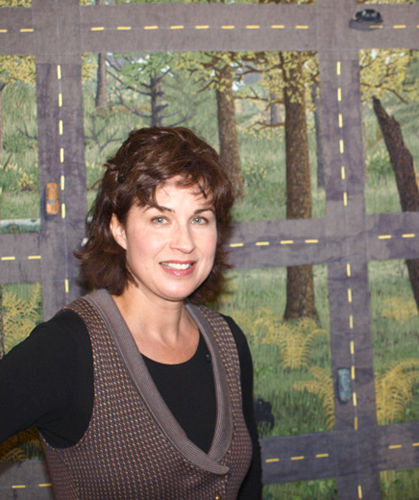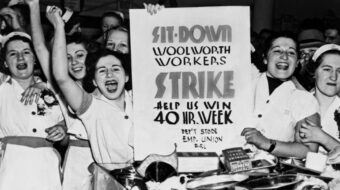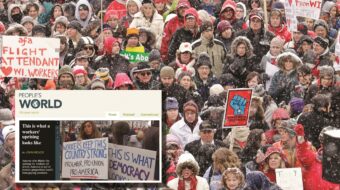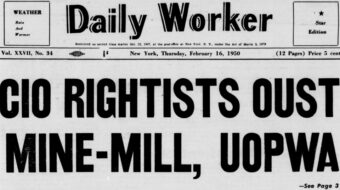
Terese Agnew is one of Wisconsin’s most honored contemporary visual artists whose “Portrait of a Textile Worker” has gleaned international attention and continues to do so. Her quilt art has been featured on PBS and her landscape sculptures and other contemporary media reside in major collections showcasing her unique social commentary and ecological sensitivity.
In informing me about another project a year from now, the tireless Agnew detailed an immediate “side project” to get the public and particularly the media to think about the important roots of our only official national holiday approved by Congress and devoted to workers. Since Labor Day is approaching Monday, September 7, that’s the project that should be put first and seemed to inspire her deepest passion when she wrote me.
Agnew is most upset at the media neglect of Labor Day, not just as celebration of working families but a reminder of the unity of effort that brought labor a vital place in a capitalist market system. It’s all being dismissed by the media as another sales day gimmick or excuse for shopping. Some of that is our preoccupation with celebrity society and apps-laden social media existence. But much is the forgotten legacy of what Americans worked for centuries to accomplish.
“Anyone who knows even a bit of labor history opens up their newspaper on Labor Day or watches TV news and withers in disappointment: gas grills 30 percent off! Rock -bottom prices on summer sportswear and back to school clothing! Sales Sales Sales!” she wrote, asking if this is truly what the day should mean.
The same lack of context occurred to me when Gov. Scott Walker opened the Wisconsin State Fair the week of the first Republican presidential debate on FOX. For personal reasons and totally void of historical knowledge of the real significance, he said he saw something prescient in how Abraham Lincoln addressed the state fair in 1859 a year before becoming president (implying he could be God’s similar gift to the nation). Well, the speech is not famous in Lincoln lore but it is known to many students of Wisconsin history since Lincoln used the occasion to push against slavery and for workers, public education and love of nature, according to the records: He exhorted his audience to “prefer free labor, with its natural companion, education.” He saw agriculture as an opportunity for “cultivated thought,” saying, “Every blade of grass is a study; and to produce two, where there was but one, is both a profit and a pleasure.” In no way is Walker’s history in office close to that measure.
Labor historians are also well aware that internationally it was May Day that was the chosen time to celebrate workers and that it was Chicago’s Haymarket protest in May of 1886 along with Wisconsin’s Bay View tragedy about the same time that spilled blood to create the eight hour day and led over decades of union activism to other improvements in working conditions that Americans now take for granted, such as child labor laws, vacations and overtime.
American business leaders, forced to concede the formidable advances organized labor brought but fearing workers’ growing strength and dreading any tinge of communism which they sought to associate in the public’s minds with international labor, went along with the push for a national holiday under President Grover Cleveland but insisted it be far removed from May. Rather typically the corporations have since sought to hijack labor’s own exciting past gains by turning the national holiday into another excuse for shopping and loafing.
So a vast history lingers behind Agnew’s anger and her sense of neglected Americana – and this seems to her the ideal time to correct the record. I asked the artist if I could spread her campaign of personal feeling, message and request beyond the confines of Wisconsin to all readers for Labor Day action, and she added a headline:
Dear Friends and Supporters of the Labor Movement,
I was 24 years old when my step-dad finally explained to me what Labor Day as a national holiday was really meant to signify. People fought and died for the 8 hour day, safe working conditions and decent pay. Workers linked arms for fair wages that could sustain a family after a job well done . . . for damn hard work as a matter of fact-work that built the US economy, the infrastructure of our country and continues to strengthen our communities to this day. It was a movement the nation agreed to set aside a day to celebrate. Workers united against all odds to counter the most powerful magnates in history-the “Robber Barons” for starters, who fought viciously against working people, maiming, murdering and all too often “crushing” them.
But here we are – not crushed yet even in Wisconsin (though a little beaten down to be sure.) Well it’s time to speak up again!
This coming Labor Day 2015 – instead of opening up the newspaper or TV news for an avalanche of sales for products made in awful working conditions across the globe – let’s write letters to the editor to our newspapers and media outlets and offer up the many compelling reasons that organized labor is more important than ever. Let’s challenge the lies and false characterizations of Unions that so often find their way into print. Let’s really celebrate Labor Day and do some educating while we’re at it.
I’ve started a list of issues that need to be told with pride, spunk and clear, hard facts. Let’s start a fresh, historically inspired, but up to the moment contemporary offensive on why Organized Labor is essential today.
Add your own to my list or pick your favorite:
The basic needs of families with parents working full time-are not SPECIAL INTERESTS-unless you think the well-being of most Americans is a special interest. (Note this recent front page story in the Washington Post underlying the modern hardship of the issue.)
Wages in the last 40 years have stagnated in the United States. The numbers coincide all too perfectly with the decline in union membership. Now, no matter how hard you work-you’re worth less than you would have been in 1975. Unless you’re in a union-and that success has been used against us!
Unlike most corporations -where the boss really is the BOSS — there is no such thing as a union boss since all union representatives are VOTED in with a majority vote by the workers they serve, and it is up to those members to make sure their leaders behave within a democratic structure.
As membership in US labor unions plummeted – from one in every three private sector workers enrolled in a union in the 1950’s to one in 20 today – the wage inequalities between black and white workers grew ever larger. The sharp decline in union jobs helps to explain racial economic gaps today.
In so-called “right to work” states, the economic well-being of workers, families and supporting public institutions are getting worse.
We need to tell the media: get the facts and report them correctly! If you spoke up before Wisconsin became a right to work -thank you. Rinse and repeat.
Happy Labor Day-I look forward to seeing you all IN PRINT!!
With all good wishes and in solidarity,
Terese Agnew
Agnew then provided Wisconsin residents with contacts, which can readily be expanded to everyone’s media outlets.
I first met Terese Agnew decades ago when she was a daring art student innovator in Milwaukee. Now she lives with her family on a farm in western Wisconsin, still active in community, labor and cultural causes with several projects as creator and participant, including a public installation project that will begin in La Crosse in October of 2016 and then move around the state resurrecting historic and iconic figures from Wisconsin’s past as inspiration for lost values and fresh appreciation of nature.
Photo: Terese Agnew standing in front of her work The D.O.T. Straightens Things Out, during PBS filming in Milwaukee. The work is in the collection of the Milwaukee Art Museum. Dominique Paul Noth.












Comments